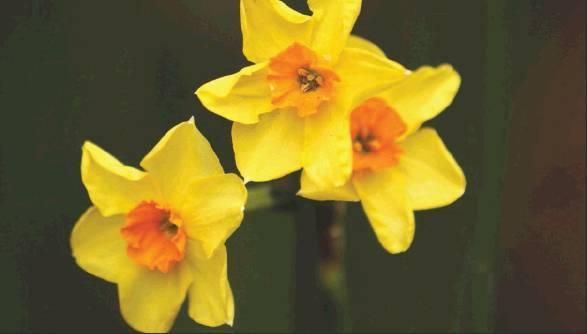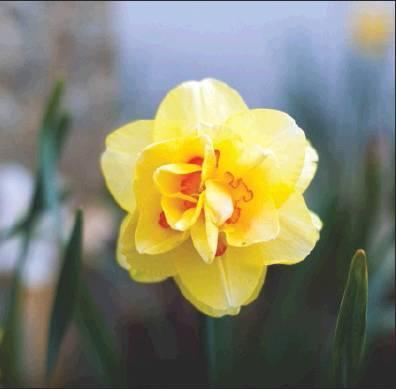Getting into Gardening
A few weeks back I was fortunate enough to meet some really nice folks. I was asked to speak at a meeting of the Spring Lake Garden Club in San Marcos – what a wonderful time and wonderful people. I thoroughly enjoyed meeting the members of the club and the several guests that had gathered. Speaking to groups of other gardeners is one of my most favorite pastimes and meeting this San Marcos group came with an added bonus – many of them are regular readers of this column. How great is that! It is always nice when people I meet come and tell me that they like what I am writing.
Being fellow gardeners, and regular readers of my articles, the questions about what the next several article topics would be was bound to come up. It did, and as I was talking about the topics I had in mind, I was reminded that I had not yet had an article on the March birth flower. Oops, I thought, I almost dropped the ball there. So, thanks to the Spring Lake Garden Club for both a wonderful time and for the gentle reminder, now on with the March birth flower.
Daffodils are the March birth flower, and I think it is the perfect choice for March. With the arrival of March comes spring, a time that all gardeners adore. The Daffodil, with its cheerful splash of yellow color signals the end of winter cold and the return of warmer days. That is just one reason I think that they, along with the Jonquil, make the perfect March birth flowers.
In the parts of the country, that are blessed with a moderate climate, (yes, we have been cold this year, but we do indeed have a moderate climate in central Texas) daffodils are among the first flowers to bust into bloom every spring, making them a terrific symbol of freshness, renewal, and rebirth. They are one of spring’s most recognizable flowers, known for their bright yellow and white petals, they are like a burst of sunshine popping out of the soil.
Gardeners tend to use the names “daffodil” and “jonquil” interchangeably. Technically, however, “daffodil” refers to large-flowered kinds with flat, strap-like leaves, while “Jonquil” denotes N. jonquilla and its hybrids; they feature smaller, fragrant, clustered blooms and cylindrical leaves with pointed tips, reminiscent of quills. If you stick to calling them all “narcissus,” you can’t go wrong.
All have the same basic flower structure. Each bloom has six outer petal-like segments that surround, and are held at right angles to, a central corona (also called the trumpet or cup, depending on its length). Daffodils range in size from 5-inch blooms on 2-foot stems to half-inch flowers on 2-inch stems and have a sweet fragrance.
Popular around Easter, the birth flower for March has its origins in the Mediterranean, including the Iberian Peninsula, North Africa and the Middle East, where it was grown by the ancient Greeks and Romans. The earliest record that included mention of daffodils dates back to just around 200 BC. Today, daffodils are most widely cultivated in Holland and Great Britain and there are over 13,000 hybrids of daffodils that range from yellow and white, to orange and pink – single petal and double petal structures, too. All are absolutely beautiful, welcome harbingers of spring.
In the language of flowers, daffodils symbolize friendship, chivalry, respect, modesty, rebirth and faithfulness. Apparently, the daffodil was originally called “affodell,” a variant of asphodel. No one really knows why the letter “d” was added to the front of the name, but from at least the 1500s the flowers have been playfully known in literature as “Daffadown Dilly” or “daffadowndilly.” Thus, daffodils.
Although daffodils were a favorite of the ancient Greeks and Romans, by around 1600 they had fallen out of favor and essentially been forgotten. But that changed in 1629 when a group of English gardeners championed the daffodil and it regained its popularity among plant and flower lovers.
The most common color of daffodil is yellow, but as I mentioned, you can also find flower varieties accented with white, orange, pink or even lime green. During Victorian times when it was taboo for someone to put their romantic feelings into actual words, daffodils were the perfect way for a gentleman to tell that certain someone that she had caught his eye.
From the Mediterranean daffodils were first taken to Britain, and from there to the rest of the world, by the Romans who thought that the sap from daffodils had varied and mystical healing powers. Actually, the sap contains crystals that can irritate the skin. The botanical or Latin name is “Narcissus” which comes from the Greek word “narkissos” and its base word “narke,” meaning a narcotic or numb sensation, attributed to the sedative effect from the alkaloids in its plants. All members are poisonous, which is great for gardeners, because that makes them critter-proof. The bulbs and leaves contain poisonous crystals which only certain insects can eat with impunity. Ancient peoples understood that they were toxic, and some Roman soldiers were even known to carry bouquets of daffodils with them into battle, to help them die more quickly if they suffered the misfortune of being mortally wounded.
The Latin name, Narcissus, actually barrows from the Greek as so many Latin words do. The Greek name for this lovely flower references the mythological character Narcissus, who loved himself too much. His arrogance ultimately led to his death. A nymph called Echo was in love with him, but Narcissus broke off the relationship. Heartbroken poor Echo hid in a cave and there she soon died. Later Narcissus, who was very handsome and quite taken with himself, saw his own face reflected in a pool of water, and as he leaned over to stare more closely at his own beauty, fell in and drowned somehow becoming the flower in the process. For this reason, daffodils can also be known as symbols of vanity.
There are different cultures around the world in which the March birth flower holds deep meanings. In China, daffodils symbolize good luck and prosperity because they bloom around the time of the Chinese New Year. In medieval times, the Arabs were known to use the juice of the wild daffodil as a cure for baldness though I am not sure it actually worked. The daffodil is also the national flower of Wales and represents faithfulness due to its ability to rebloom year after year at the same time. In Wales it is worn on St. David’s Day, celebrated every year on March 1st. Another, somewhat less known meaning of daffodils was noted to be “you are an angel.” And the American Cancer Society uses the daffodil to represent hope for a cure.
A Greek scholar named Theophrastus first wrote about daffodils around 300 BC in his Enquiry into Plants, which became an important influence on medieval science. It is his writings that made their way to Britten, along with the daffodil itself, that ensured the beautiful spring flower would come to be known and loved all over the world.
Because the daffodil is one of the first flowers of spring, it is also symbolic of hope. If your birthday falls in March, hopefully someone will remember you and send a happy bouquet of bright spring daffodils your way.
Certainly, one of the first flowers of spring brings us new beginnings and, as the poet Keats said, daffodils bring “joy forever”. With their bright yellow petals, daffodils seem the perfect way to say that the sun is always shining whenever your loved one is around.





